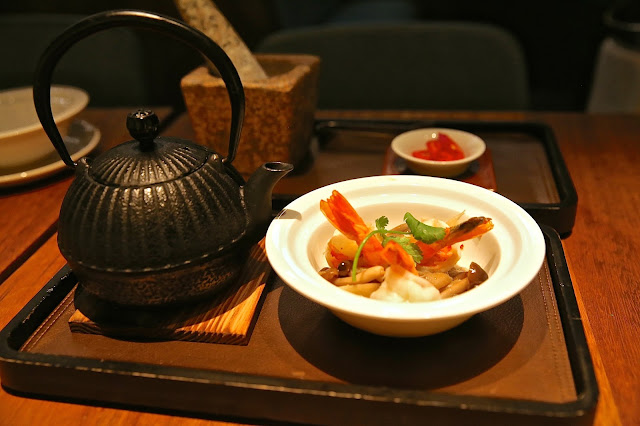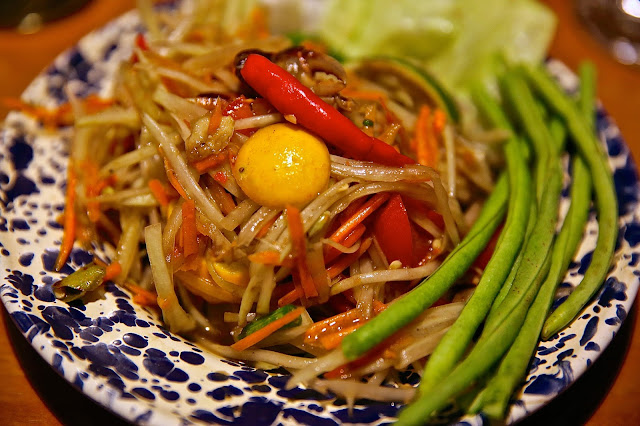Name: Patara Berners Street
Where: 5A Berners Street, London, W1T 3LF, http://www.pataralondon.com/restaurant/berners-street/
Cost: Average spend per person is around £45 not including drinks. From the à la carte menu, starters are priced from £9.50 to £14.50, mains from £16.75 to £45. There are two set menus - Patara Pride is £45 per person with soup, and includes 5 starters, 4 mains plus accompanying rice and vegetable sides and dessert. The Patara Platinum is £65 per person for the same number of dishes but featuring some more luxurious items like Wagyu beef, king scallops and black cod. There is also a vegetarian set menu for £40 per person.
About: Patara Berners Street is the latest London branch of the group, and opened in December 2015.
The Patara Group is known in London as a fine-dining Thai option with a reputation for top quality cooking, and Berners Street joins branches in Oxford Circus, Soho, Knightsbridge, South Kensington and Hampstead, as well as international branches in Bangkok, Beijing and Singapore.
The restaurant is situated just a few metres north of bustling Oxford Street, next to the Berners Tavern in the trendy London Edition Hotel.
It has an über-sleek look, clean and modern if a tad bland, with low level lighting, plain teak tables, green leather seating.
What We Ate: We wanted to choose our own dishes so opted for à la carte rather than the set menus. We started with the Chor Muang (£8) – these were beautifully presented, flower-shaped lilac dumplings filled with caramelised chicken and a peanut and coconut cream. Sweet, savoury and with a light but glutinous pastry casing, I enjoyed these.
Next were the chilli and sea salt calamari (£10.50) seasoned with fresh red chilli, black pepper, spring onion and garlic. As ubiquitous as this dish is in Chinese and southeast Asian restaurants, it is one I can't stop myself from ordering. Patara's version was highly seasoned, crispy and as moreish as it gets.
We then had fresh rolls with battered deep-fried soft shell crab and prawn (£10.25), filled with basil, carrot, mint and roasted peanut, and served with a chilli lime dressing. These were as refreshing as a Vietnamese summer roll, but I could hardly detect any soft shell crab in them, and so at this price point I thought they were not great vfm.
The salad of prawn and crispy beignet (£12.25) was tossed with cashews, mint, lemongrass and shallot, with a roasted chilli dressing. This had some great textures and tasted fresh and zingy, though the dressing was too sweet for my palate. I think of beignets as being balls of deep-fried dough, but what I saw in the salad were crispy little slivers.
Prawn tom yum soup (£9.50) was beautifully presented in a black cast-iron Japanese teapot, with an accompanying pestle and mortar and chilles, so that diners can adjust the heat of the soup to their own taste. The soup combined prawn, shimeji and oyster mushrooms, simmered in a broth of evaporated milk and fish sauce with galangal, lemongrass and kaffir lime. This was refreshing, well flavoured and delicious.
And then on to the mains - the curry was a chicken Kieaw Wan (£16.75), made from free-range chicken, aubergine and bamboo shoot in a green curry paste made in-house. The most ubiquitous of Thai dishes, chicken green curry to many signifies Thai cooking at its most popular, and it is a dish I nearly always order. Patara’s had tender chicken in a richly creamy curry with heady Thai basil, green chilli and coconut milk. This was one of the highlights of the meal for me, and beautifully served in a copper pot.
The fish main was a whole lemon sole (£24), filleted and cut into thin slices, served battered and deep-fried over its bones, accompanied by a green mango salad with coconut, chilli, cashews and shallot. I really wanted to love this dish, but like the prawn salad it was a tad too sweet for my liking, and lacked the zinginess, freshness and overall balance I was hoping for.
The main meat dish was one Patara’s signature dishes, and one I have tried before and loved – the coconut braised beef (£16.75). This had meltingly tender slow-braised beef in a lime-coconut cream reduction, finished with mint, lemongrass and coriander; rich, creamy and delicious, and I was very happy to have revisited it at Patara Berners Street.
The king prawn Pad Thai (£19.50) had a couple of whopping shellfish more like lobsters than prawns, and the taste was as good as it gets.
We had a couple of accompaniments including stir-fried morning glory, Thailand's number one green vegetable (£8.95). With chilli, ginger and mushroom sauce, this had a lovely texture and wok-breath.
The riceberry red Thai rice, roasted with sweet coconut water (£7.50), came served in a dinky young coconut shell, and had a lovely nutty flavour.
What We Drank: Patara Signature Cocktails, all with a Thai twist, range from £9.75 to £12. The entry level white wine is a South African Chenin Blanc (£22), with the red being a Shiraz/Cabernet blend from Berton Vineyards, Australia (£22).
We kicked off proceedings with a couple of Patara Signature cocktails. The Hendrick's Sour (£10), blended gin with lime juice and cucumber, garnished with fresh coriander. The Sake Popping Boba (£11.50) featured sake shaken with Jack Daniel's, St Germain elderflower liqueur, honey and jasmine tea.
With the meal itself, we shared a bottle of Alsatian Pinot Blanc 2014, from Dopff (£26). With apple and melon flavours, this was a nicely rounded wine with enough richness to balance the spicy food. It was also surprisingly well priced.
Likes: A perfect meal for me here would include Pad Thai, chilli and sea salt calamari, coconut braised beef and morning glory. The restaurant is well located close to Soho and London’s theatreland.
Dislikes: A couple of dishes were unbalanced - a tad too sweet, and lacking in freshness or acidity.
Verdict: Berners Street is a great addition to the Patara collection of fine-dining Thai restaurants in central London. The coconut braised beef and chicken green curry are to die for, and I would very happily return for them. Recommended.































































